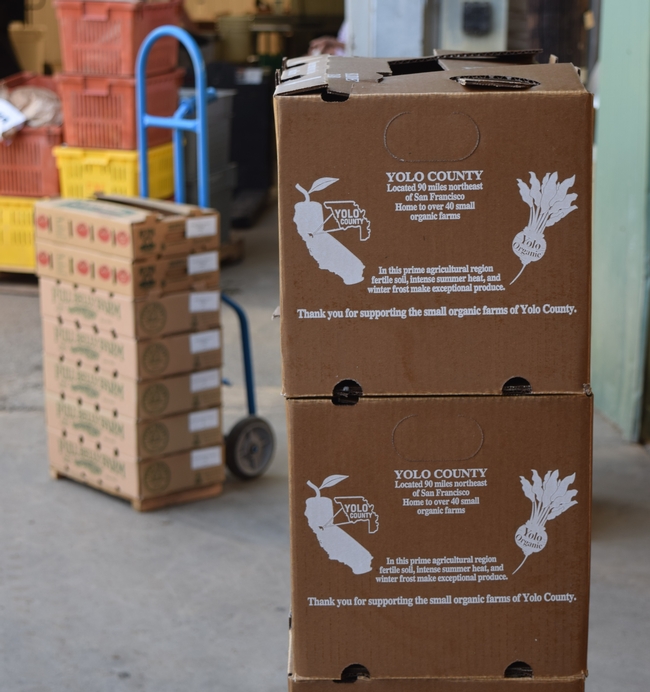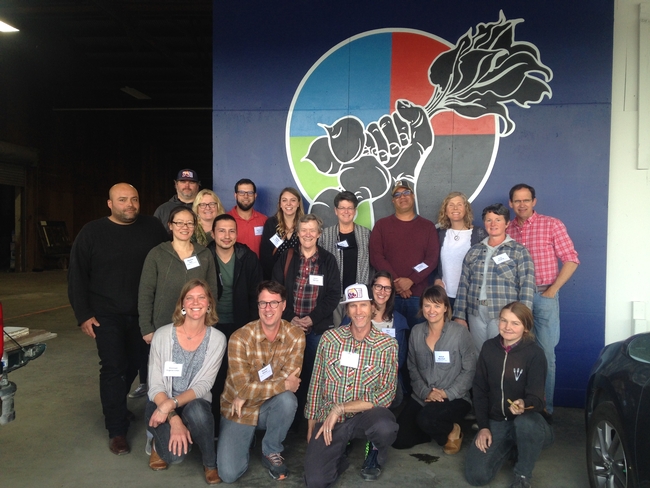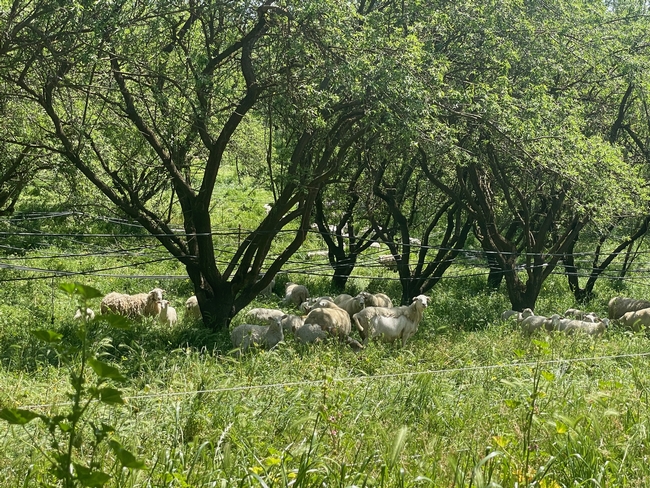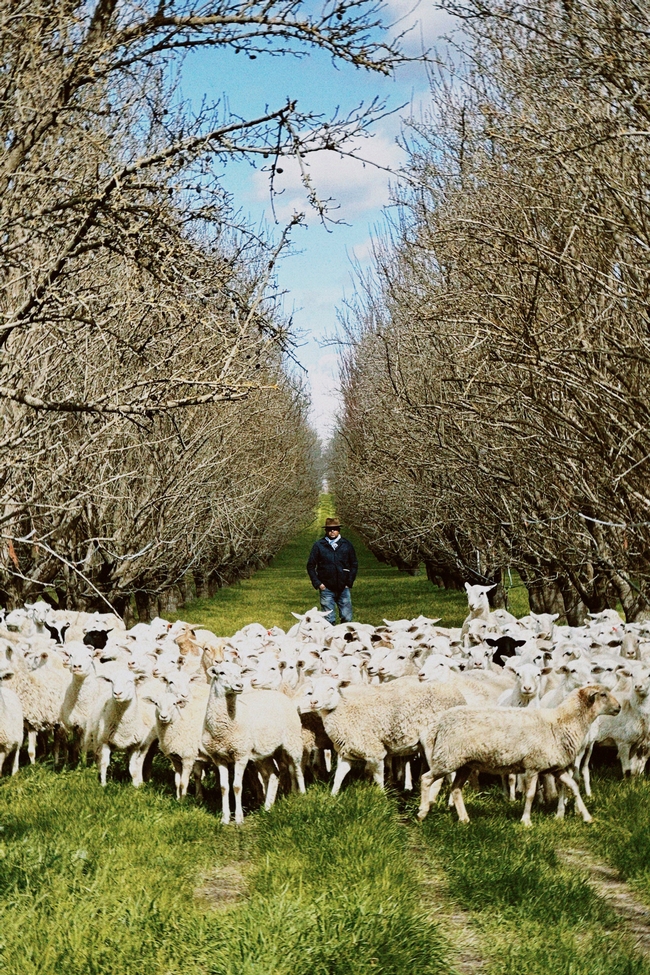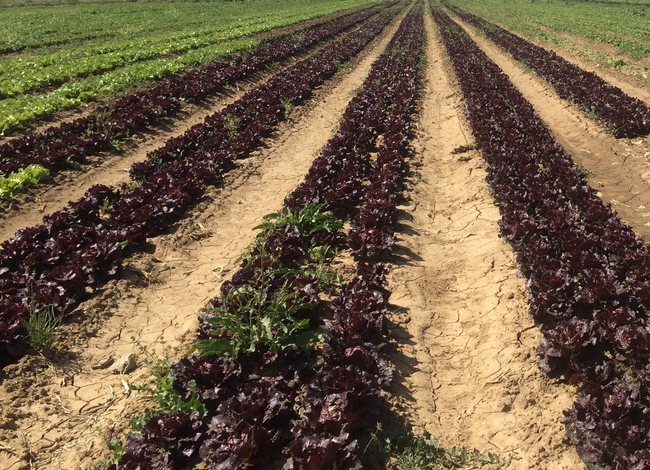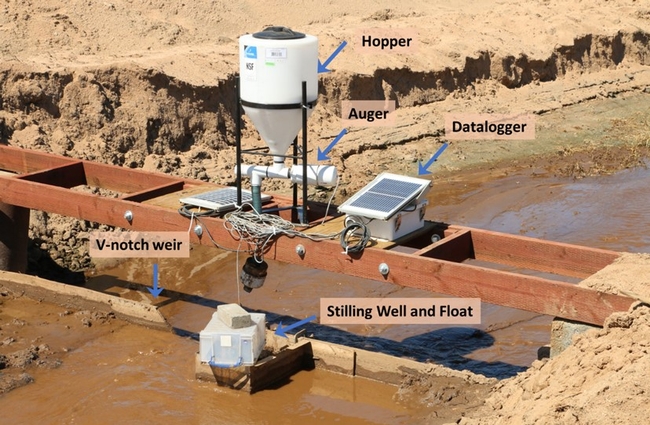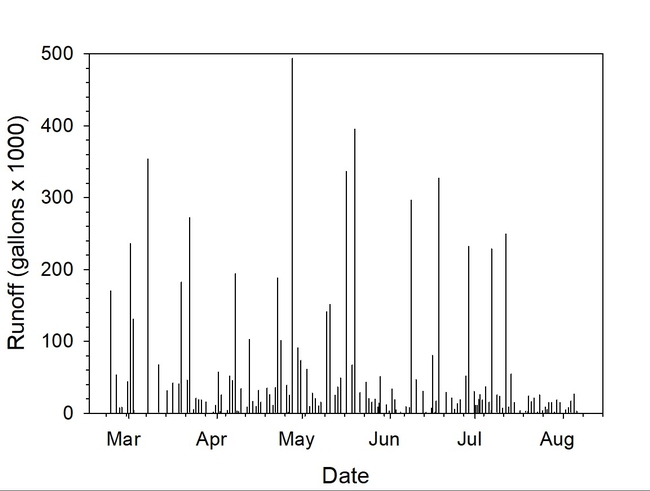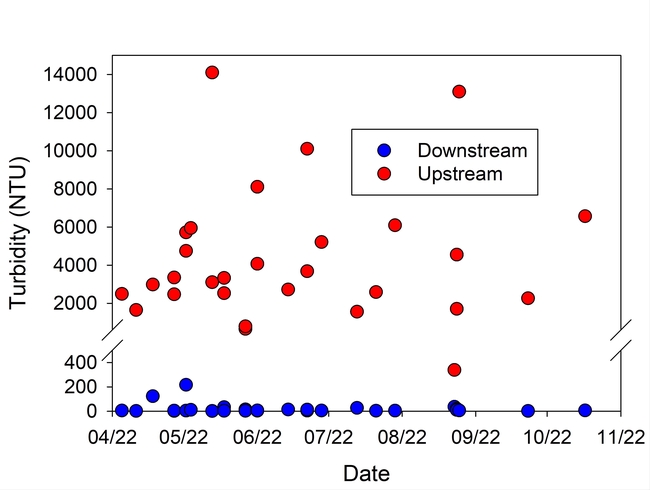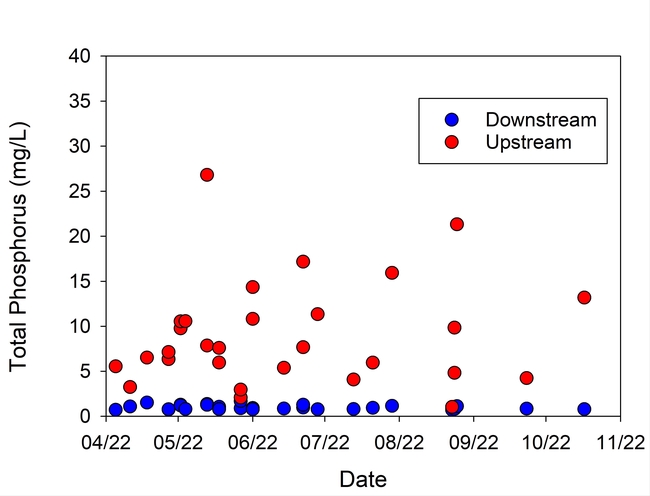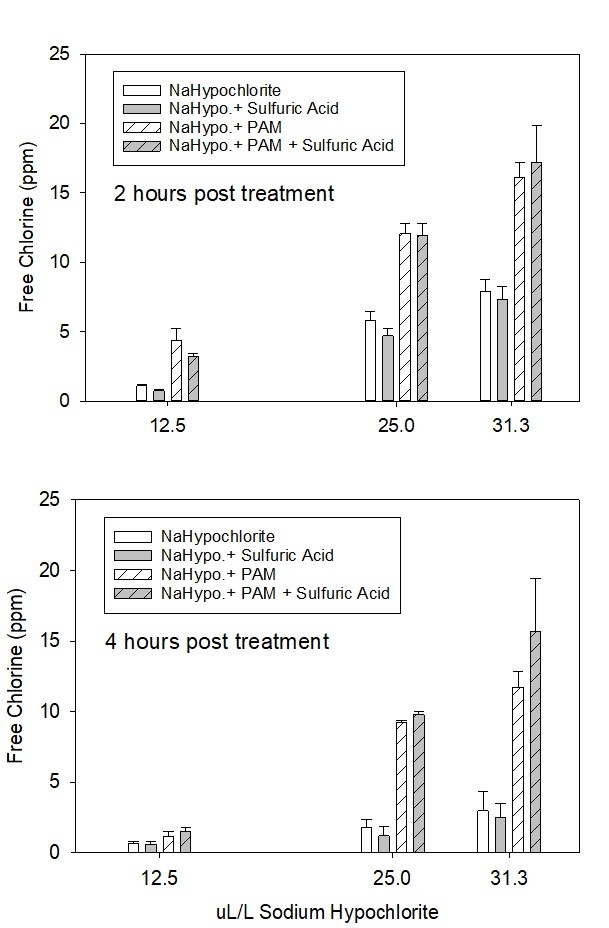Posts Tagged: food safety
Lawn-pocalypse! Surviving Drought
Ah, summer! The season of sunburns, pool parties, and… lawn droughts. If your once lush, green carpet now looks like a crunchy brown doormat, you're not alone. Let's dive into why your yard is staging a dramatic death scene and what you can do to...

Bermuda grass and weeds overtaking drought stressed turf grass.
Equipment sanitation survey (broomrape and other pests/pathogens)
A group of crop pest management and food safety researchers across the U.S. is currently gathering grower and ag industry information on field equipment sanitation practices with the ultimate goal of designing research to address needs of the...

SCRI Sanitation QR slides-UCD

SCRI Sanitation QR slides-UCD2
Winter season: A time for food safety systems re-evaluation and education for food hubs
The holiday meal season is often a busy time for food hubs – entities that handle the aggregation, distribution and/or marketing of source-identified regional food – as restaurants, retailers and consumers fill their tables and shelves with an abundance of fresh, local products. However, the subsequent winter months can provide a valuable time for reflection and re-evaluation of a food hub's systems and processes. In this spirit, it may be helpful to remind people working at food hubs that University of California Sustainable Agriculture Research and Education Program (UC SAREP) offers a suite of food-safety resources – in English and in Spanish – on its website.
- A step-by-step guide for food hubs on how to pursue a third-party food safety audit with guidance on how to navigate buyers' questions.
- Two sample food-safety plans intended as a starting point to be adapted to a food hub's specific operations and practices.
- Example standard operating procedure, or SOP, documents related to 11 common tasks carried out by food hubs.
“We hope these resources can play a role in helping food hubs to adopt best practices and control risks related to food safety,” says Gwenael Engelskirchen, sustainable food and farming coordinator with UC SAREP, who led the development of these educational tools.
According to the Centers for Disease Control and Prevention, approximately, 1 in 6 Americans (or 48 million people) gets sick and 3,000 die of foodborne diseases annually. In 2011, to help prevent the occurrence of foodborne illness, the federal government enacted the Food Safety Modernization Act (FSMA), designed to outline actions to be taken at various points along the supply chain for both human and animal food.
UC SAREP's Food Safety Resources for Food Hubs are intended to help food hubs navigate these food-safety regulations and accompanying best practices. Resources are also available in Spanish at Recursos de seguridad alimentaria para los centros de distribución de alimentos.
Food safety certification guide
Some buyers verify a supplier's food safety program by requiring an audit performed by a third-party certification body or auditing company. This Guide to Food Safety Certification offers key considerations before deciding to pursue a food safety audit and helps users navigate the food safety certification process.
Food safety plan
Food hubs that meet the criteria for full compliance with FSMA's Preventive Controls for Human Food Rule are required to have a food-safety plan in place. And for all food hubs, having a shared document describing the facility's operations and how potential risks of food contamination are managed is a good idea. Two sample food safety plans, inspired by the operations of food hubs in California, provide a starting point and can be adapted to a hub's own operations.
Standard operating procedures
Standard operating procedures provide detailed step-by-step instructions for how to carry out operational tasks within a food facility. The standard operating procedure samples cover common topics such as handwashing, facility cleaning and more, and are intended to be adapted to a food hub's specific operations and practices.
Jacob Weiss from Spork Food Hub in Davis said, “the templates were a great starting place for us to build the framework of our food safety plan. It helped us figure out what we needed to (and didn't) need to include. I think the SOPs are also really useful because they are broad enough to get you started but flexible enough to add the specific practices of your business or hub.”
For additional information, visit UC SAREP's webpages on Food Safety Resources for Food Hubs or Recursos de seguridad alimentaria para los centros de distribución de alimentos.
These resources and tools were developed in collaboration with various project partners, including Department of Food Science and Technology at UC Davis, Department of Population Health and Reproduction at UC Davis School of Veterinary Medicine, Center for Precision Medicine and Data Science at UC Davis Health, and Community Alliance with Family Farmers.
USDA awards $2 million to study livestock grazing in organic orchards
UC, The Organic Center, University of Rhode Island partner on $3.5m food-safety study for organic produce growers
Grazing sheep and other livestock can help convert cover crops to fertilizer for orchard crops. To develop best management practices, the University of California and The Organic Center are collaborating on research to help organic orchard growers safely incorporate livestock grazing into their farming practices. The project is funded by a $2 million grant recently awarded through the U.S. Department of Agriculture's Organic Agriculture Research and Extension Initiative research program.
Interest in grazing livestock on cover crops in nut orchards has increased in recent years. However, research is needed to determine the best way to improve soil health and pest suppression, and to address concerns about food-borne pathogens and food safety.
“Organic farmers typically follow the USDA National Organic Program standards for raw animal manure, waiting 90 to 120 days between incorporating raw manure into the soil and harvesting the crop,” said Alda Pires, UC Cooperative Extension urban agriculture and food safety specialist in the School of Veterinary Medicine at UC Davis.
“Little research has been conducted to verify adequate waiting periods to reduce contamination risks in integrated crop-livestock production systems,” she said. “This research will fill the knowledge gap and facilitate the development of science-based food safety guidelines for grazing small ruminants in orchards.”
For this four-year project, “Influence of Orchard Grazing on Soil Health and Pest Control While Mitigating Food Safety Risk,” the scientists will study organic almond, walnut and pistachio orchards in two distinct nut-growing regions in California – the Sacramento Valley and San Joaquin Valley. The scientists will assess the effects of livestock grazing of cover crops on bacteria populations, soil health, pest control and economics.
Building soil health
“Growers have consistently raised the need for more information on grazing impacts on nutrient availability during tree growth, as well as potential to build up the biological, physical and chemical pillars of soil health,” said Amelie Gaudin, associate professor and endowed chair of agroecology in the UC Davis Department of Plant Sciences.
Livestock grazing may provide an opportunity to quickly enhance the amount of nitrogen that can be used by plants and microbes when the cover crop is terminated. “This project will help growers develop nitrogen budgets for these more diversified systems and quantify additional benefits and potential tradeoffs for soil health – such as compaction and salinity – to guide the development of place-based best management practices,” Gaudin said.
Pest management
Houston Wilson, UC Cooperative Extension specialist in the Department of Entomology at UC Riverside, will be studying the effects of livestock grazing on orchard pests.
“Navel orangeworm, or NOW, is by far the most destructive pest of almonds and pistachios,” Wilson said. “These moths overwinter in unharvested nuts in the orchard, and so removal and destruction of remnant nuts over the winter is the foundation of NOW control. While farmers typically use machinery to do this, grazing with animals may present a unique alternative that is more cost-effective and provides additional ecosystem benefits, such as soil health and weed control.”
Outreach to farmers
As part of the project, The Organic Center was awarded $75,000 to work with UC Agriculture and Natural Resources to direct national extension and education outreach activities. These will include a social media campaign, webinars and educational sessions and a technical report for growers.
“There is an increasing interest from organic farmers to learn how to incorporate livestock into their operations to gain better soil health and fertility,” said Amber Sciligo, director of science programs at The Organic Center.
“This research is very exciting because it will holistically explore the potential risks and benefits of livestock not just to soil health, but also pest control – a truly interdisciplinary project that matches the whole system of the organic farm.”
Produce food-safety management tools
For another organic food-safety project, Pires and Sciligo will be working with Patrick Baur, professor of Sustainable Agriculture and Food Systems at the University of Rhode Island.
The University of Rhode Island and The Organic Center received $3.5 million from USDA's Organic Agriculture Research and Extension Initiative research program for the new organic food-safety education project.
“We're going to develop a new food safety management tool designed specifically for organic soil amendments,” said Baur, who is leading the project. “We're also going to develop a suite of new communication and training tools aimed at the entire fruit and vegetable sector to build a shared language between organic agriculture and the food safety community and help them work better together.”
As part of the produce project, Pires of UC Davis was awarded $1.16 million to conduct a risk assessment and create a publicly accessible dashboard to meet the specific needs of organic growers operating at different scales, under different cropping systems, in different regions.
Also participating in this project will be Beatriz Martinez Lopez, professor in the School of Veterinary Medicine at UC Davis, and Abhinav Mishra and Govindaraj Dev Kumar of the University of Georgia.
New approaches to using polyacrylamide (PAM) to reduce sediment and sediment bound pesticides and nutrients in runoff and improve chlorine efficacy: Part II—an auger applicator for treating irrigation runoff in farm ditches
Minimizing suspended sediments in irrigation runoff is desirable for several reasons. For growers reusing tailwater for watering their crops, they must assure that the water has minimal food safety risks by testing it for generic E coli and/or treating it with chlorine. The concentration of free (or reactive) chlorine is reduced when tailwater contains a high concentration of suspended sediments. Treating a large volume of tailwater with chlorine can be a significant expense over a season so it is important to be able to remove as much of the suspended sediments as possible before treatment.
A second reason is that water quality regulations under Agriculture discharge Order 4.0 requires tailwater discharged into public water ways to not be toxic to aquatic organisms. Pesticides that strongly bind to soil, such as pyrethroids, are carried on the suspended sediments in runoff which can cause toxicity to aquatic organisms that live in creeks and rivers downstream from farms. Also, particulate forms of N and P which bind with the suspended sediments pose a water quality risk to receiving waterbodies such as the sloughs and wetlands along the coast. Both nutrients can spur algal blooms which reduces dissolved oxygen available to fish and other aquatic organisms.
In a previous article we discussed a new approach to using Polyacrylamide (PAM), an inexpensive polymer molecule for reducing soil erosion, to treat sprinkler water. This practice uses a specialized applicator (Fig. 1) to condition water flowing from a well with PAM. An advantage of this method is that the cartridges in the applicator release a small amount of PAM (1 to 2 ppm) into the irrigation water, which flocculates soil particles that could potentially become suspended and transported in runoff. Field tests using a prototype version of this applicator resulted in about 90% less suspended sediment in the tailwater when treated with PAM compared to untreated irrigation water.
Auger ditch applicator
A second approach we developed for reducing suspended sediment in runoff is to use a smart applicator that can automatically apply dry PAM to the runoff water flowing in farm ditches. This type of applicator is suspended on a platform above a ditch and uses a hopper filled with dry PAM and an auger system controlled by an electric motor and small computer to drop PAM down a tube into the flowing runoff (Fig. 2). A weir and float mechanism located upstream are used to monitor the flow rate of the runoff so that the computer can adjust the frequency that PAM is applied. A video at this link demonstrates how the auger applicator operates.
Field testing of the ditch applicator
A yearlong study at a commercial farm showed that the ditch applicator was effective in removing 98% of the suspended sediments transported in runoff (Table 1, Fig. 3). Based on the total runoff measured in a single drainage ditch during the 2022 season (21.5 acre-feet), an estimated 106 tons of sediment were removed (Fig. 4).
Turbidity in the runoff was reduced by more than 99%, and Total P and N were reduced on average by 89% and 60%, respectively, during the season (Table 1, Figs. 5 and 6). These reductions in nutrient load, suspended sediment, and turbidity could greatly improve water quality in water bodies downstream from farms that discharge irrigation runoff.
Table 1. Average concentration of N, P, and sediments carried in irrigation runoff before (upstream) and after (downstream) treatment with the PAM ditch applicator (April – October 2022). Average of 32 paired grab samples from 3 farm ditches. Downstream locations varied from 300 to 500 ft downstream from the PAM applicators.
Ditch applicator vs well applicator
Although more effective at reducing suspended sediment in runoff than the well applicator, the ditch applicator required more maintenance. PAM needed to be added to the hopper once or twice per week during the irrigation season, and sediment that settled in the ditches had to be cleaned out periodically using a backhoe. Also, removed sediment had to be spread back in the fields. The well applicator only required periodic refilling of the cartridges with PAM, and minimizes the amount of sediment that settles out in the drainage ditches.
PAM effects on chlorine requirement
To evaluate the effect of PAM on the quantity of chlorine needed to treat runoff, we performed a laboratory assay on samples of sprinkler runoff collected upstream and downstream of one of the ditch applicators. The turbidity of the upstream (untreated) and downstream samples (PAM treated) was 2276 and 9.5 NTU, respectively. The electrical conductivity of the runoff samples was 1.35 dS/m and the pH was 8.4 before adding chlorine. The main factors evaluated in the assay were sodium hypochlorite concentration and acidification with 10% sulfuric acid. Presumably, acidifying the runoff to a pH of 6.5 should increase the concentration of the more reactive form of chlorine, hypochlorous acid which is more effective as a microbial disinfectant. Residual free chlorine concentration of the treatments was evaluated 2 and 4 hours after adding 12.5% sodium hypochlorite at concentrations ranging 12.5 to 31.3 ul per liter of runoff (100 to 250 ul of 12.5% NaOCl per L of water).
The laboratory assay showed that reducing suspended sediment concentration using PAM increased the efficacy of chlorine treatment of runoff. The free chlorine concentration for PAM treated runoff was more than twice the concentration measured in the untreated runoff for all sodium hypochlorite concentrations evaluated after 2 hours and more than three times the concentration after 4 hours (Fig. 7). Free chlorine concentration in the PAM treated runoff was more than 2.5 ppm two hours after treatment at the lowest concentration of chlorine evaluated (12.5 ul/L) but was less than 0.5 ppm in the untreated runoff. To attain similar chlorine efficacy as PAM treated runoff, untreated runoff would require twice as much sodium hypochlorite (25 ul/L). These chlorine requirements would correspond to 26 and52 gallons of 12.5% sodium hypochlorite to treat and acre-foot of runoff with and without a PAM pretreatment, respectively.
Acidification of the runoff to a pH of 6.5 with sulfuric acid increased the free chlorine concentration in the PAM treated runoff at the highest concentration of sodium hypochlorite (31.3 ul/L) after 4 hours. Acidification did not have a significant effect on free chlorine concentration for the other treatments.
Summary
Both versions of the dry PAM applicators (well and ditch) show promise for greatly reducing soil erosion, as well as helping improve water quality and the efficacy of chlorine for treating tail water reused for irrigation. By considerably reducing the concentration of suspended sediment in irrigation runoff, chlorine can be more effective as a disinfection agent, and better control E. coli and other microbial pathogens that could potentially cause public health risks.
Acknowledgments: We greatly appreciate assistance in fabricating the prototype PAM applicators from RayFab. This project was funded by the California Leafy Green Research Board.
Further reading

